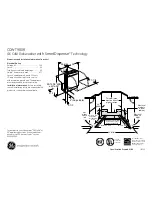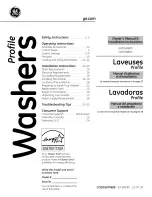
23
3. Slide the dispenser cover to the left, and then press down on the ridged arrow to
close.
HOW MUCH DETERGENT TO USE
The amount of detergent to use depends on the hardness of your water and the
type of detergent. If you use too little, dishes won’t be clean. If you use too much
detergent in soft water, glassware will etch.
Water Hardness
Water hardness varies depending on your source. For the best results, your
dishwasher is designed to operate with water that has a hardness of no more than 7
grains per gallon. Test kits are available from all major appliance parts retail outlets.
If your water has a hardness over 8 grains per gallon, you may consider installing
a water softener or regularly use an additive to enhance the performance of your
detergent.
Soil Level of Load
Depending on how much soil is on your dish load, you may need to adjust the
amount of detergent.
PROPER USE OF RINSE AID
Your dishwasher is designed to use a LIQUID rinse aid. Using a rinse aid greatly
improves drying performance after the final rinse.
Rinse aids prevent water from forming droplets that can dry as spots or streaks.
They also improve drying by allowing water to drain off of the dishes during the final
rinse by releasing a small amount of the rinse aid into the rinse water. Your Rinse Aid
dispenser is designed to use a liquid rinse aid. Do not use a solid or bar-type.
RINSE AID DISPENSER
Under normal conditions, you will need to fill the rinse aid dispenser approximately
once a month. Rinse aid is released through an opening in the dispenser. You do not
need to wait until the dispenser is empty to refill it. Try to keep it full, but be careful
not to overfill it.
1. Open the dishwasher door.
2. Turn the rinse aid dispenser cap counterclockwise and pull up to remove.
















































